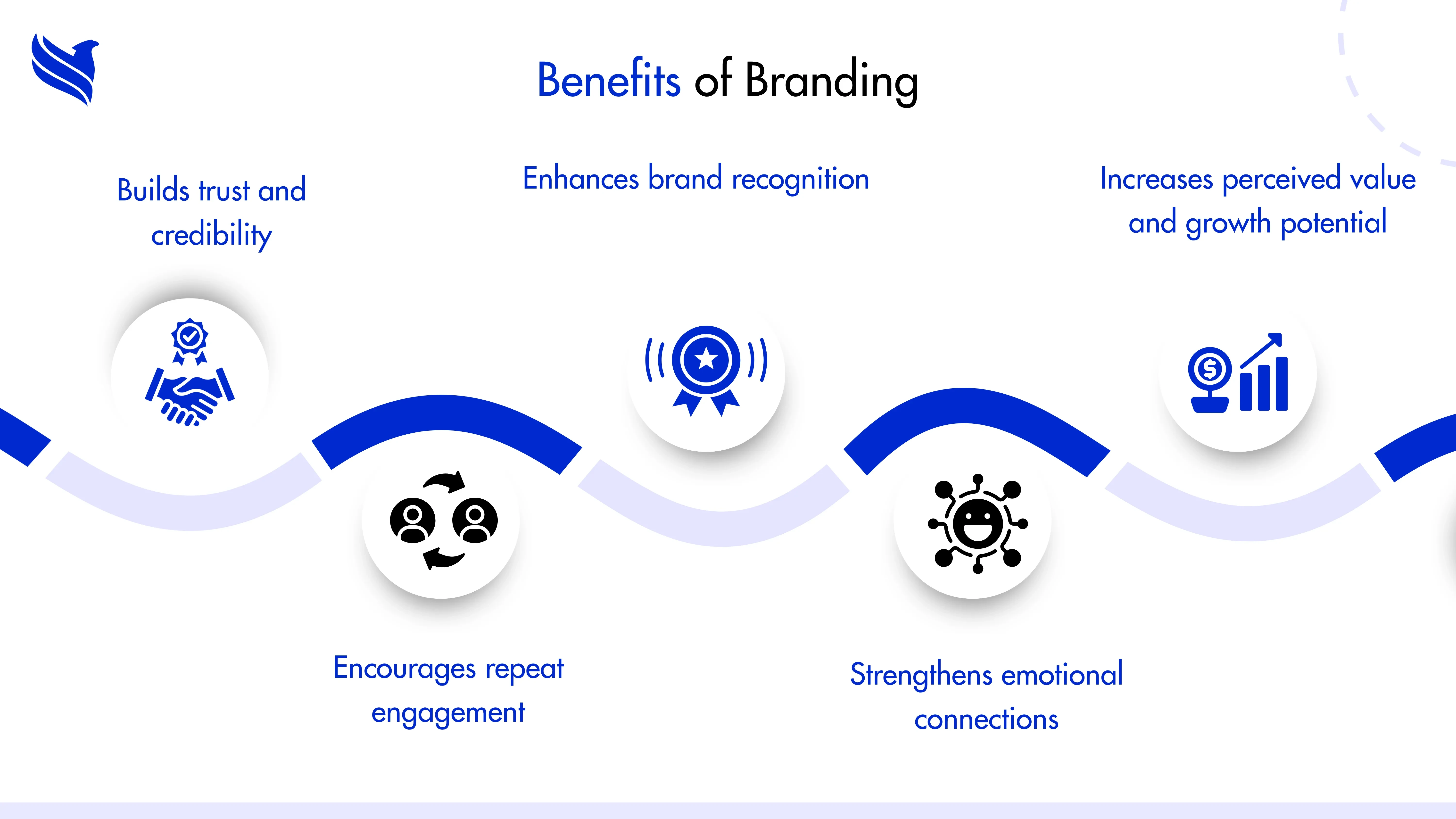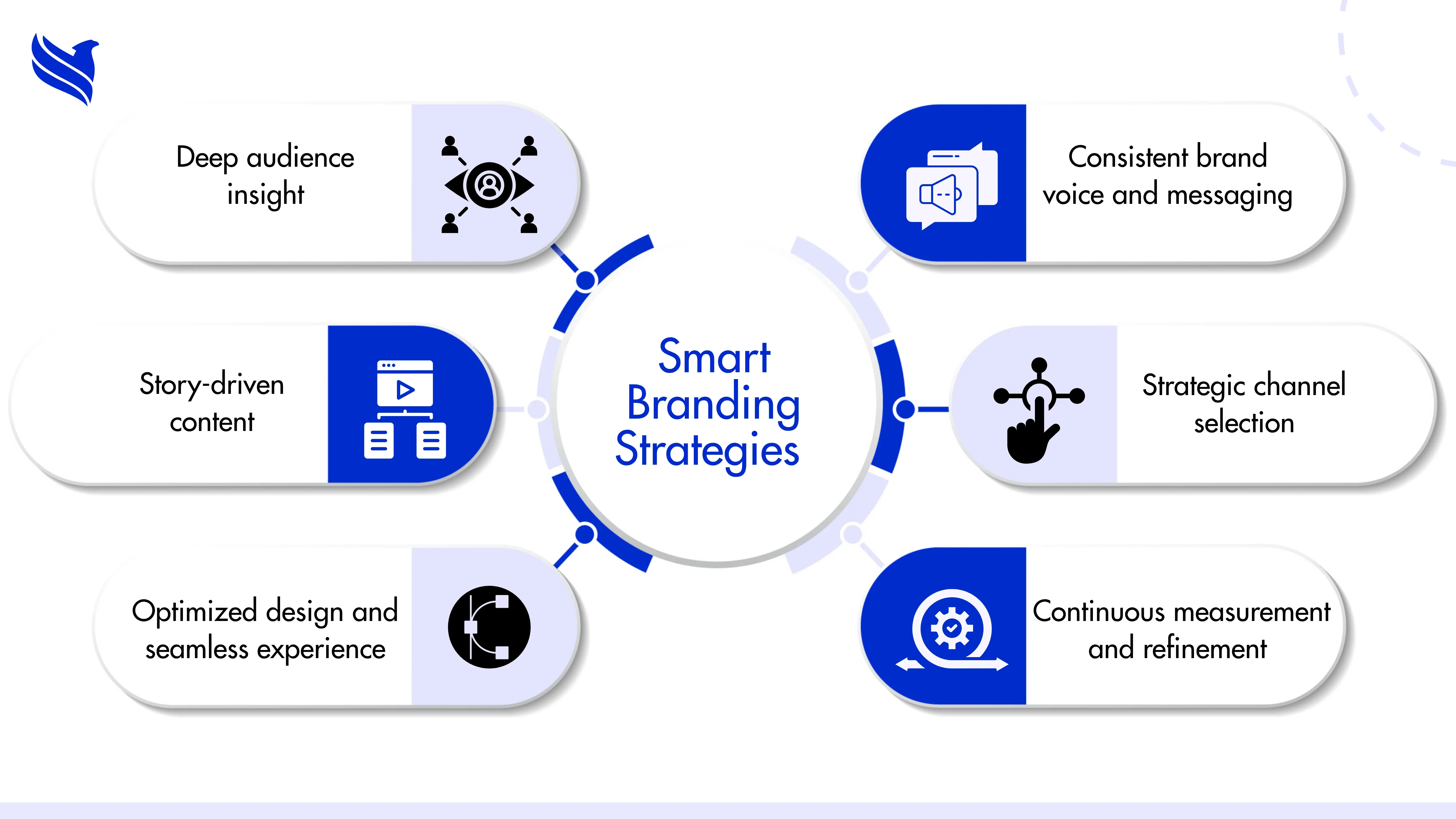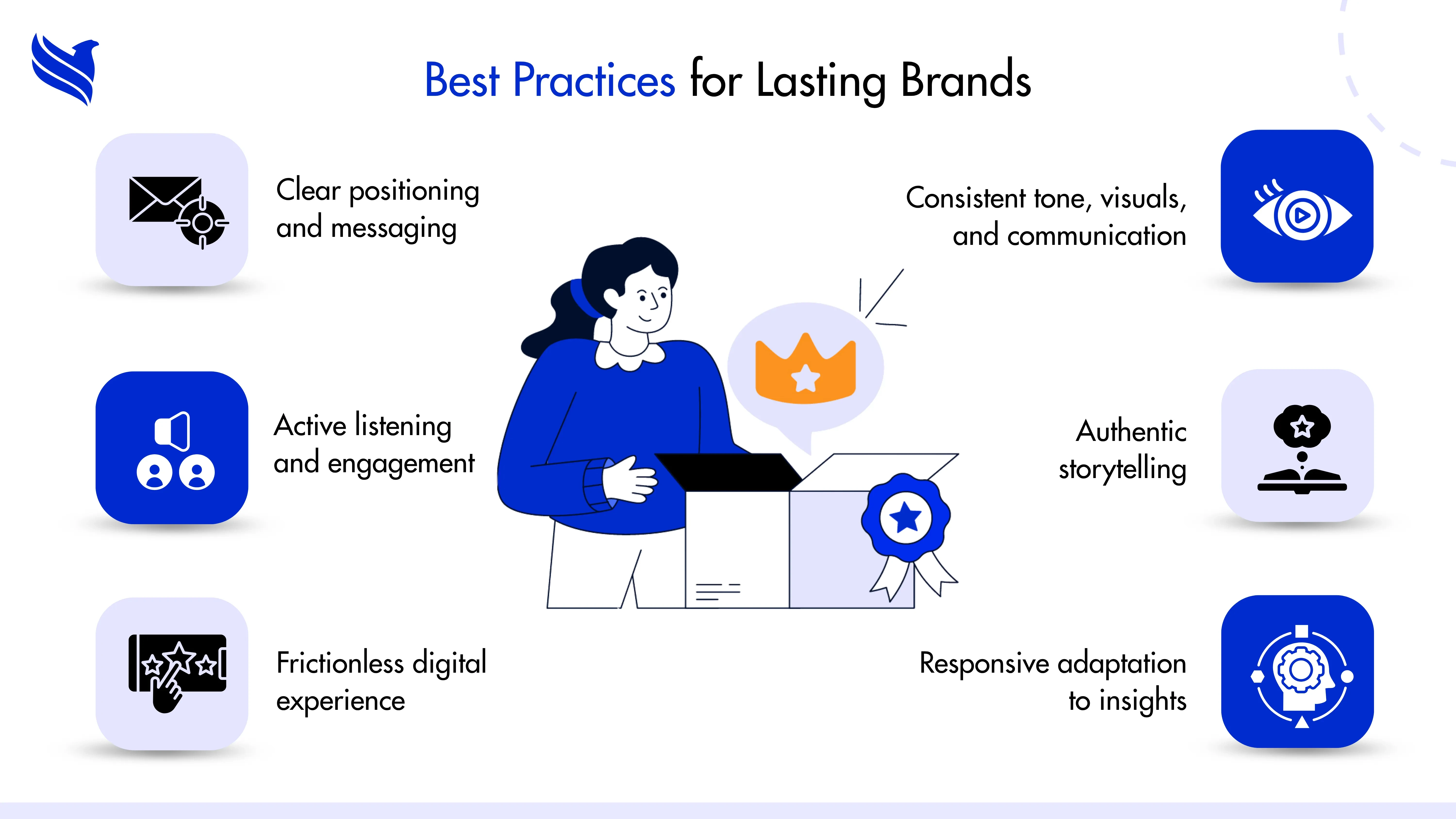Quick summary - People rarely remember an ad. They remember a feeling, a vibe, a tiny moment that clicks. That’s what digital branding does. It sneaks in everywhere, the colors, the tone, the way a page moves, and slowly builds trust. This guide explores the messy, human side of branding, showing how consistency, design, and stories make a business stick.
- What is digital branding and why does it matter so much?
- Digital branding vs. Digital marketing — What’s the real difference?
- The real benefits of branding for a business
- Digital branding services that actually do something
- Smart strategies that actually make brands stick
- Best practices that actually make a brand last
- The future of branding in digital marketing
- The final word on building a brand that lasts
Discover how digital branding quietly shapes recognition, trust, and loyalty. Learn the strategies and insights that turn fleeting attention into lasting connections.
Some stories stick. You remember the tone, the color, maybe even the way it made you feel, without ever realizing why. That’s branding in digital marketing. It’s not a logo or tagline sitting quietly in a corner of your website. It’s the personality people sense before they know your name.
In today’s digital noise, everything moves too fast. Ads scroll by, promises blur, attention fades. What stays behind is the brand that felt real. The one that didn’t shout but spoke clearly. That’s what makes the difference between a business that’s noticed and one that’s remembered.
The truth is, branding in digital marketing isn’t about perfection. It’s about building brand people care to return to. Something human. That’s where design, voice, and experience collide, and suddenly, it feels less like selling and more like connection.
And yes, building all that takes time. Many businesses lean on outside experts to keep their message sharp and their identity consistent. Sometimes, that’s what keeps the brand alive when everything else feels rushed.
In this guide, the focus is simple, understanding how digital branding quietly shapes success in every corner of digital marketing.
What is digital branding and why does it matter so much?
Ask ten people what digital branding means, and you’ll hear ten different answers. Some talk about logos, others about Instagram grids or clever taglines. But strip all that away, and it’s really about the feeling people carry after every online encounter with a business. It’s the quiet connection that builds when a brand shows up the same way, everywhere; honest, clear, human.
These days, anyone can launch a campaign overnight. But not everyone can build meaning that lasts. That’s what branding and marketing together can do, it makes your business recognizable when everything else looks the same. It’s not the design alone or the story alone. It’s both, woven into every click, color, and word.
And here’s the truth: when a brand feels real, people don’t scroll past it. They stop. They listen. They remember. That’s the importance of branding.
Digital branding vs. Digital marketing — What’s the real difference?
It’s strange how often people mix these two up. They sound similar, sure, but they move differently. Branding and marketing work together but serve different purposes. Digital marketing is the hustle. It’s the thing you do every day, campaigns, keywords, ads, analytics. The visible stuff. The measurable stuff. Branding, though, sits underneath all of it. It’s the quiet layer that shapes how people see you long after the ad fades.
Branding isn’t chasing. It’s attracting. Marketing reaches out. Branding pulls in.
One is a sprint, the other is a long walk. You can run a dozen smart campaigns, hit your clicks and conversions, but if the brand doesn’t mean anything, if it doesn’t feel like anything, people won’t stay. They’ll scroll past. Or worse, forget you ever existed.
Think of it like this:
| Factors | Branding | Marketing |
| Purpose | Builds emotion, shapes memory | Generates awareness, drives action |
| Pace | Gradual, lasting | Quick, goal-driven |
| Focus | Identity and trust | Tactics and performance |
| Result | Loyalty, reputation | Sales, engagement |
Good marketing can grab attention for a moment. Strong branding makes that attention mean something. They depend on each other, one creates noise, the other gives it a voice.
And maybe that’s the simplest way to put it:
- Marketing tells the world you exist.
- Branding gives them a reason to care.
Even small things matter, a tiny color tweak, a tone in a message, the feeling when someone clicks your page. That’s branding in business sneaking in where marketing can’t reach. When both work together, a business stops chasing visibility and starts building belief.
The real benefits of branding for a business
Branding isn’t neat. It isn’t just a logo or a slogan that looks nice on a screen. It’s messy. It’s how people feel when they see a business pop up in their feed. It’s the tiny recognition that happens in a split second, the color, the tone, the familiarity. And slowly, over time, it changes everything.
The first thing branding does is make a business recognizable. Maybe someone forgets your ad or the exact product you sell, but they remember the feeling. That flicker of familiarity becomes trust. And trust? That’s what makes people pick one brand over another, sometimes even without thinking.
Then there’s loyalty, the sneaky kind. Customers come back, not because of discounts, but because they feel something. They remember the vibe, the personality, the consistency. They tell friends, defend the brand online, and forgive mistakes because there’s a sense of reliability there. Without it, a company is just another name in the noise.
Consistency matters too. Every touchpoint, from emails to posts, to the way support responds, adds to the story. A messy post, a random tone, a mismatch in colors, it sticks out. Branding keeps things aligned. Not perfect, just steady enough that people know what to expect.
Some benefits, roughly:
- Trust & credibility: People feel confident choosing you.
- Loyalty: Repeat customers who stick around.
- Recognition: Standing out in a sea of sameness.
- Emotional connection: People buy feelings, not products.
- Value: Strong brands can command higher prices and grow faster.
That’s the benefits of brand awareness and the broader benefits of branding for a business, trust, loyalty, and long-term recognition that outlasts any single campaign.
Branding isn’t decoration. It’s scaffolding. It turns random moments into meaning, weak clicks into lasting impressions. Over time, it becomes bigger than campaigns, bigger than ads, bigger than the products themselves. It becomes something people remember, even when you aren’t there.
Digital branding services that actually do something
Brands online aren’t just logos slapped on a website or a few posts on Instagram. Anyone can do that. What makes a brand stick is invisible. It’s the feeling someone gets when they see a name, the tiny moment that makes them think, “I trust this.” Digital branding services exist because, without them, all that effort gets lost in the noise. But here’s the thing, it’s messy. No one ever said branding was clean or easy.
Some people think branding is just marketing. It’s not. It’s strategy, storytelling, and a lot of trial and error. Done well, it makes a business memorable. Done poorly, it’s noise. And most of the time, it’s hard to tell the difference without experience.
Here’s what businesses actually get when they invest in digital branding services:
- Brand identity creation – This is where it starts. Logos, colors, fonts, the vibe of the brand. It’s more than visuals, it’s personality. And it matters because people notice inconsistency, even if they can’t say why. A mismatched brand looks sloppy. A consistent one? It feels trustworthy.
- Content strategy – Blogs, social media posts, newsletters, videos. It’s tempting to post whatever seems trendy. That rarely works. The goal is content that feels real, human, aligned with what the brand stands for. Some businesses go deep, targeting different audience pockets with slightly different messages. It’s tedious but it works. People notice.
- Website & App design (UI/UX focus) – Here’s the silent work. Smooth navigation, clean layouts, intuitive buttons, they’re often invisible, but when they’re missing, users notice fast. Frustration drives people away. Good design isn’t just pretty; it’s understanding how people think, how they click, how they scroll. It’s invisible persuasion.
- Social media management & engagement – Posting and hoping is not a strategy. Social media needs listening, responding, showing you’re alive. A small reply, a timely story, even a little humor, it all counts. Brands that feel human are the ones people remember.
- Analytics & performance tracking – Numbers aren’t boring if you read them right. Engagement rates, clicks, conversions; they tell stories about what’s working and what’s not. Brands that ignore the numbers are flying blind. Brands that listen can change, tweak, improve, and survive.
- Reputation management & digital PR – One angry review, one viral post, one misunderstood tweet can undo months of effort. Watching the sentiment, responding carefully, amplifying the good, it’s exhausting, but necessary. Every impression matters.
Therefore, we can say that digital marketing needs a personal touch. Because people connect to people, not automation.
That’s why outsourcing these services can save sanity and keep things consistent. Experienced teams bring fresh eyes, attention to detail, and can actually handle the constant little tweaks that make a brand feel alive. Internal teams can try, but it’s rare they sustain the effort without distraction.
At the end of the day, digital branding isn’t flashy. It’s not about viral campaigns every week. It’s connecting dots, being consistent, and showing up so people remember. Done right, it builds trust, recognition, and loyalty, the kind of things that actually grow a business. Done wrong, it’s noise, wasted hours, and frustration.
The work is messy, human, and imperfect. But that’s exactly why it works. People connect to people, not robots. And branding, at its core, is all about making those connections.
Smart strategies that actually make brands stick
Digital branding isn’t tidy. It’s not neat boxes, graphs, or glossy campaigns. It’s messy. It's a little chaotic. And that’s why strategy matters; it gives direction without pretending things are simple. Without it, even smart ideas vanish. With it, small, uneven steps start to add up, slowly, in ways people notice.
The first thing any brand has to get straight is who they’re talking to. Not just age or location. The messy stuff. The habits. The frustrations. The little things people do online without thinking. That’s where the real insight hides. Brands that understand this don’t just post, they connect. They feel human. It takes time, patience, and a lot of observation. There’s no shortcut.
Consistency comes next. Brands that flip-flop in tone or try to please everyone don’t stick. The voice matters. It could be playful, serious, sarcastic, or reassuring, but it has to feel the same across posts, replies, campaigns. People notice patterns, even if they can’t name them. Those patterns build trust. Slip once and it’s confusing. Keep it steady, and people remember.
Then there’s content that actually tells a story. Not random posts. Not flashy trends that vanish in a week. Stories. Small stories. Behind-the-scenes, customer wins, mistakes, lessons learned. Little things that make a brand real. Every piece should tie into a bigger picture, even loosely. It’s subtle. But it works.
Picking the right channels is a sneaky part of strategy. Not every platform is worth the effort. Some brands chase every trend and end up everywhere and nowhere at once. The smart ones go where their audience actually is. They put energy where it counts. Less noise, more signal. It’s quiet, but it matters more than flashy campaigns.
Design and experience are next, quietly crucial. A messy website, confusing buttons, slow pages, they frustrate instantly. Smooth design isn’t decoration. It’s part of the story. It says, “this brand knows what it’s doing.” Every scroll, click, and hover counts. People feel it even if they don’t think about it.
And finally, tracking and tweaking. Numbers aren’t reports, they’re clues. Where engagement spikes, where people drop off, where clicks happen, it all tells a story. Ignore it, and you’re guessing. Pay attention, adjust, try again. Brands that last are always learning, always tweaking. Static strategy dies fast.
The thing about these strategies is how tangled they get. Audience research shapes messaging. Messaging shapes content. Content shapes channel choice. Channels shape design. Design shapes engagement. Engagement feeds data. Data feeds changes. It’s messy, circular, imperfect. Exactly why it works.
Digital branding isn’t a single campaign. It’s ongoing. Strategy is the pulse, sometimes uneven, sometimes slow, but alive. Done right, it makes a brand human, recognizable, and worth remembering. Done poorly, it’s noise. In a world that scrolls fast and forgets faster, strategy is the difference between a fleeting impression and a lasting connection.
Best practices that actually make a brand last
Most brands think posting a few graphics or following trends is enough. It isn’t. A brand that sticks does the messy, quiet work, the stuff no one notices at first but builds over time.
- Clarity first – A brand has to know what it stands for. Not a slogan, not a tagline. Real values. Simple, human messages. When people sense uncertainty, they pull away. Ambiguity is invisible, but it kills recognition faster than any bad design.
- Consistency, Even when boring – It’s not just logos or colors. It’s voice, tone, behavior. Every interaction, every post, every comment has to feel like the same person speaking. Small details matter. Consistency builds trust slowly. Inconsistency spreads doubt.
- Listen more than talk – Social media isn’t a bullhorn. It’s a messy, ongoing conversation. Brands that pay attention, respond thoughtfully, and adjust quietly gain more than followers, they earn credibility. Engagement isn’t likes or shares, it’s noticing, reacting, showing up human.
- Stories beat hype – Random viral posts are fleeting. Stories stick. Customer wins, failures, behind-the-scenes moments, these make a brand feel alive. Strategy without story is forgettable. People remember emotions, not sales pitches.
- Smooth experiences matter – Websites, apps, emails, they all tell a story. Friction frustrates instantly. Slow pages, confusing buttons, unclear navigation, they chip away at trust. Smooth design isn’t decoration; it’s part of reputation. People sense it, even if they don’t name it. Hence, the role of UI/UX in digital marketing is quiet but essential to trust.
- Adapt, don’t freeze – Metrics aren’t judgment; they’re signals. Drop in engagement, odd spikes, sudden trends, brands that survive respond. They tweak. They try again. Static strategy dies quickly. Habits, instincts, small adjustments, these are the real best practices.
- Human touch wins – Automation, AI tools, they help. But people connect with people. A reply, a thoughtful comment, a story, they make a brand feel alive. Humanity paired with consistency and focus builds credibility.
The key is that none of this is neat. None of it is instant. Best practices aren’t formulas, they’re behaviors repeated, adjusted, and lived daily. Little, uneven actions, small human touches, small corrections, they build recognition, loyalty, trust.
A brand that follows these practices quietly becomes memorable. It doesn’t scream. It doesn’t demand attention. It earns it. In a world full of noise, the difference between a fleeting name and one people remember is the human effort behind the scenes, the consistency, the stories, and the attention to detail that no one notices until it works.
The future of branding in digital marketing
Brands won’t just exist online, they’ll feel alive or die unnoticed. The scroll never stops. People swipe past logos, ads, posts. They forget names before the next notification hits. The brands that matter won’t be the loudest. They’ll be the ones that leave tiny marks, a comment that feels personal, a story that resonates, a design that just works without anyone thinking about it.
Personalization will rule, but not the kind tracked by numbers. People can tell when a brand is pretending. They notice the small gestures: a reply that actually listens, a story that feels human, a subtle acknowledgment of what someone cares about. That’s where loyalty grows. Algorithms can suggest, predict, even automate, but they cannot replicate instinct. Timing, empathy, subtle judgment, humans still hold that edge.
The tools will help, yes, but the messy, human decisions will define the difference. Brands that adapt, notice, and correct quietly will survive. Slow-loading pages, confusing navigation, clunky experiences, they erode trust faster than any missed campaign.
The future isn’t polished. It’s rough. Imperfect. Human. Brands that embrace that, that care about the small invisible things, that adjust and learn, will endure. The rest fade into the endless scroll, forgotten, like dust on a screen.
The final word on building a brand that lasts
Branding isn’t a logo or a tagline. It’s a living, messy thing connecting every action, every interaction, every experience. Done right, it builds trust. Done wrong or ignored; it vanishes. Digital branding is human work. Strategy, storytelling, design, UX, social media; they all collide, imperfectly, but in ways that matter.
The brands that survive will be those that notice, adapt, and act, guided by smart branding and marketing strategies, supported by the right digital marketing services, and grounded in empathy.
Digital branding is imperfect, human, alive. That’s why it works. The brands that do it right will be remembered. The ones that don’t? Gone. Simple as that.
FBSPL helps businesses do the right things in the right way, strategy, execution, human insight, so the brand survives, grows, and actually matters. Because surviving in the digital world isn’t about being everywhere; it’s about being human where it counts.
Written by
Bhavishya Bharadwaj
Bhavishya Bharadwaj is the Digital Marketing Manager at FBSPL, bringing over a decade of experience across insurance, outsourcing, accounting, and digital transformation.Frequently Asked Questions
They keep all the messy stuff in check: identity, content, engagement, reputation. They make sure the small details that matter most aren’t overlooked. Without them, the brand risks being forgettable.
Consistency ensures your audience experiences the same voice, visuals, and messaging everywhere. It builds recognition, reinforces credibility, and makes your brand memorable, so every interaction strengthens trust rather than causing confusion.
Because people notice friction before they notice your logo. Slow pages, buttons that don’t make sense, confusing flows; it chips away at trust. Smooth experiences silently convince people that a brand knows what it’s doing.
A strong digital brand shapes perception before a customer even considers a purchase. It builds trust, creates familiarity, and sparks emotional connection, making people more likely to choose your business over competitors, even when options seem similar.
Absolutely. Big budgets can’t buy authenticity. Being human, being consistent, telling real stories, these stick far longer than ads ever could. Small brands often win hearts where big ones can’t.

